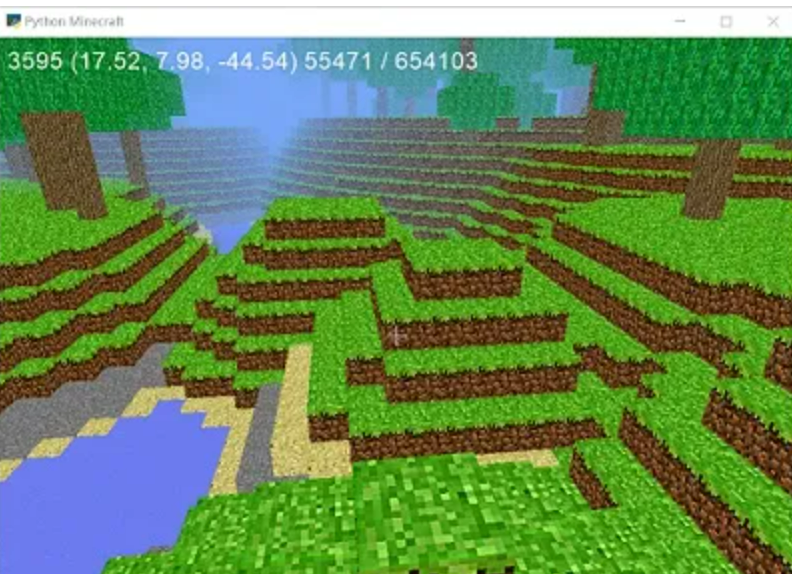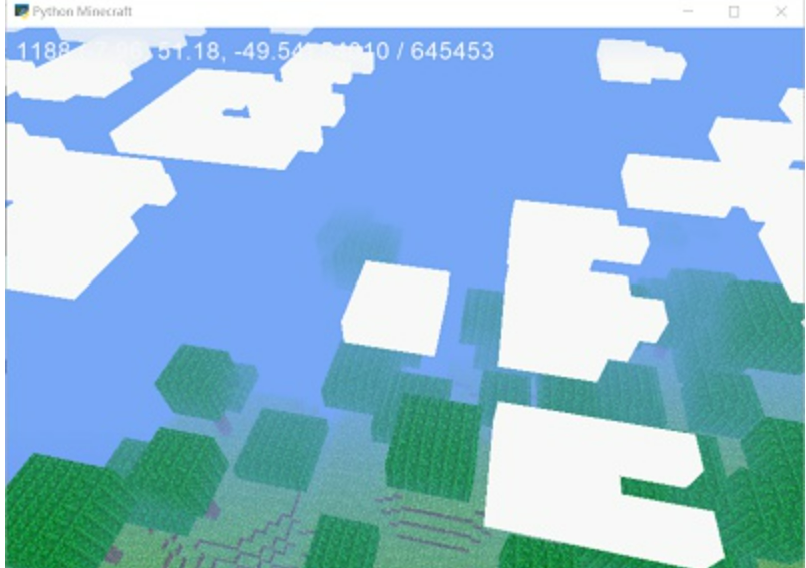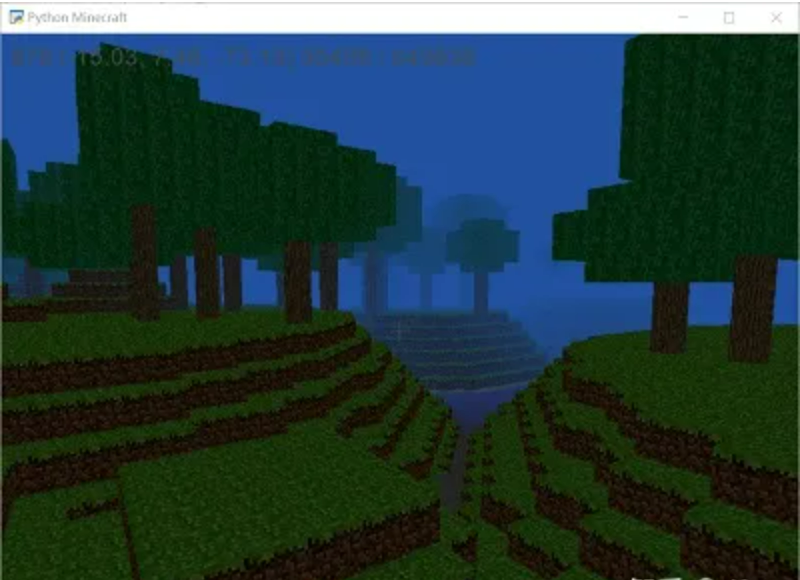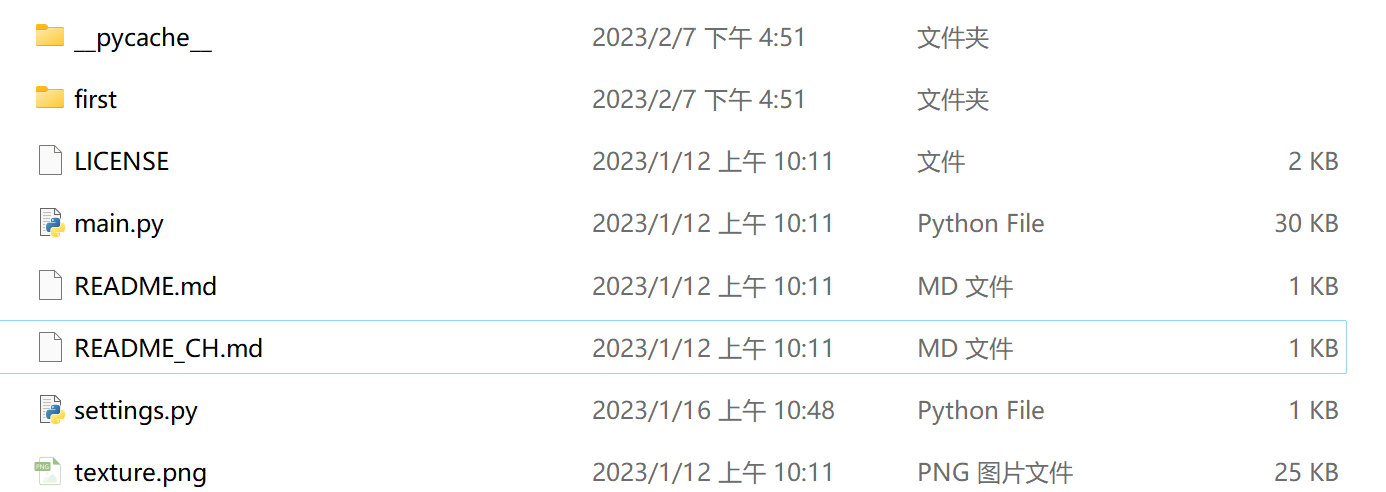你有没有想过用python制作一个Minecraft?在github上就有这样一个python程序(链接:https://github.com/zifan-wang/Minecraft.git),玩起来还像模像样的:
一.游戏截图



二.代码分析
在游戏的文件夹中共有这些文件:

1.main.py
代码:(如有需要可复制,不需要可直接跳过)
import sys
import random
import time
import numba as nb
import threading
from collections import deque
from pyglet import image
from pyglet.gl import *
from pyglet.graphics import TextureGroup
from pyglet.window import key, mouse
from settings import *
SEED = random.randint(10, 1000000)#656795(种子"akioi") # 世界种子
print('seed:', SEED)
def cube_vertices(x, y, z, n):
# 返回立方体的顶点,大小为2n。
return [
x-n,y+n,z-n, x-n,y+n,z+n, x+n,y+n,z+n, x+n,y+n,z-n, # top
x-n,y-n,z-n, x+n,y-n,z-n, x+n,y-n,z+n, x-n,y-n,z+n, # bottom
x-n,y-n,z-n, x-n,y-n,z+n, x-n,y+n,z+n, x-n,y+n,z-n, # left
x+n,y-n,z+n, x+n,y-n,z-n, x+n,y+n,z-n, x+n,y+n,z+n, # right
x-n,y-n,z+n, x+n,y-n,z+n, x+n,y+n,z+n, x-n,y+n,z+n, # front
x+n,y-n,z-n, x-n,y-n,z-n, x-n,y+n,z-n, x+n,y+n,z-n, # back
]
def tex_coord(x, y, n=8):
# 返回纹理的边界顶点。
m = 1.0 / n
dx = x * m
dy = y * m
return dx, dy, dx + m, dy, dx + m, dy + m, dx, dy + m
def tex_coords(top, bottom, side):
# 返回顶部、底部和侧面的纹理列表。
top = tex_coord(*top)
bottom = tex_coord(*bottom)
side = tex_coord(*side)
result = []
result.extend(top)
result.extend(bottom)
result.extend(side * 4)
return result
GRASS = tex_coords((1, 0), (0, 1), (0, 0))
SNOW = tex_coords((4, 0), (0, 1), (1, 3))
SAND = tex_coords((1, 1), (1, 1), (1, 1))
DIRT = tex_coords((0, 1), (0, 1), (0, 1))
STONE = tex_coords((2, 0), (2, 0), (2, 0))
ENDSTONE = tex_coords((2, 1), (2, 1), (2, 1))
WATER = tex_coords((0, 4), (0, 4), (0, 4))
ICE = tex_coords((3, 1), (3, 1), (3, 1))
WOOD = tex_coords((0, 2), (0, 2), (3, 0))
LEAF = tex_coords((0, 3), (0, 3), (0, 3))
BRICK = tex_coords((1, 2), (1, 2), (1, 2))
PUMKEY = tex_coords((2, 2), (3, 3), (2, 3))
MELON = tex_coords((2, 4), (2, 4), (1, 4))
CLOUD = tex_coords((3, 2), (3, 2), (3, 2))
TNT = tex_coords((4, 2), (4, 3), (4, 1))
DIMO = tex_coords((3, 4), (3, 4), (3, 4))
IRNO = tex_coords((4, 4), (4, 4), (4, 4))
COAL = tex_coords((5, 0), (5, 0), (5, 0))
GOLDO = tex_coords((5, 1), (5, 1), (5, 1))
# 立方体的6个面
FACES = [
( 0, 1, 0),
( 0,-1, 0),
(-1, 0, 0),
( 1, 0, 0),
( 0, 0, 1),
( 0, 0,-1),
]
random.seed(SEED)
def normalize(position):
# 将三维坐标'position'的x、y、z取近似值
x, y, z = position
x, y, z = (round(x), round(y), round(z))
return (x, y, z)
def sectorize(position):
x, y, z = normalize(position)
x, y, z = x // SECTOR_SIZE, y // SECTOR_SIZE, z // SECTOR_SIZE
return (x, 0, z)
persistence = round(random.uniform(0.25, 0.45), 6)
Number_Of_Octaves = random.randint(3, 5)
PMAGN = persistence * 16
HAMPL = 8
threads = deque() # 多线程队列
@nb.jit(nopython=True, fastmath=True)
def Noise(x, y):
n = x + y * 57
n = (n * 8192) ^ n
return ( 1.0 - ( (n * (n * n * 15731 + 789221) + 1376312589) & 0x7fffffff) / 1073741824.0)
@nb.jit(nopython=True, fastmath=True)
def SmoothedNoise(x, y):
corners = ( Noise(x-1, y-1)+Noise(x+1, y-1)+Noise(x-1, y+1)+Noise(x+1, y+1) ) / 16
sides = ( Noise(x-1, y) +Noise(x+1, y) +Noise(x, y-1) +Noise(x, y+1) ) / 8
center = Noise(x, y) / 4
return corners + sides + center
@nb.jit(nopython=True, fastmath=True)
def Cosine_Interpolate(a, b, x):
ft = x * 3.1415927
f = (1 - math.cos(ft)) * 0.5
return a*(1-f) + b*f
@nb.jit(nopython=True, fastmath=True)
def Linear_Interpolate(a, b, x):
return a*(1-x) + b*x
def InterpolatedNoise(x, y):
integer_X = int(x)
fractional_X = x - integer_X
integer_Y = int(y)
fractional_Y = y - integer_Y
v1 = SmoothedNoise(integer_X, integer_Y)
v2 = SmoothedNoise(integer_X + 1, integer_Y)
v3 = SmoothedNoise(integer_X, integer_Y + 1)
v4 = SmoothedNoise(integer_X + 1, integer_Y + 1)
i1 = Cosine_Interpolate(v1, v2, fractional_X)
i2 = Cosine_Interpolate(v3, v4, fractional_X)
return Cosine_Interpolate(i1, i2, fractional_Y)
def PerlinNoise(x, y):
x = abs(x)
y = abs(y)
noise = 0
p = persistence
n = Number_Of_Octaves
for i in range(n):
frequency = pow(2,i)
amplitude = pow(p,i)
noise = noise + InterpolatedNoise(x * frequency, y * frequency) * amplitude
return noise
class mbatch:
def __init__(self):
self.batch = {}
def add(self, x, z, *args):
x = int(x / 64) * 64
z = int(z / 64) * 64
if 







 最低0.47元/天 解锁文章
最低0.47元/天 解锁文章















 3074
3074











 被折叠的 条评论
为什么被折叠?
被折叠的 条评论
为什么被折叠?








